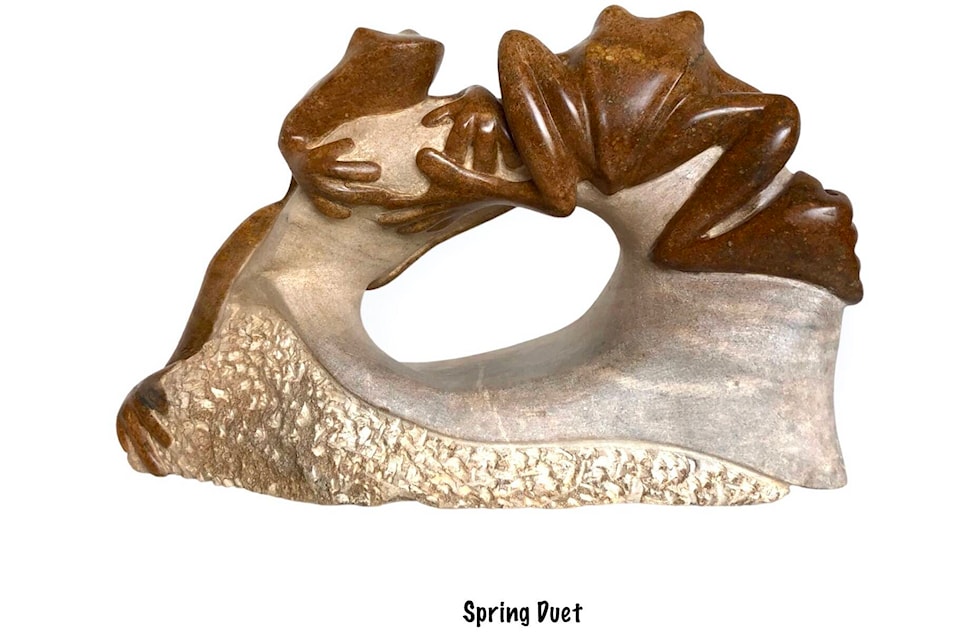If your concept of art is rooted in work in two dimensions, you’re about to have your eyes – and mind – opened to the possibilities of adding a third.
In a month-long exhibition, The Best of 3 Dimensions – running May 4 to 27 at White Rock’s Landmark Pop-Uptown Gallery at Central Plaza – the Sculptors Society of BC will highlight the work of 11 artists from across the province.
The opening, with artists in attendance, will be May 4 from 5 to 9 p.m.
Organized by Peninsula sculptor Bruce Kleeberger (a professional in the field for the last 10 years), the show will include his work along with that of Lynden Beesley, Kathi Bond, David Dumbrell, James Fletcher, Laurent Maynard, Beverly Patterson, Sharon Reay, Linda Schmidt, Rom Simmer and Bill Thomson.
Highlighted will be sculptural work in a variety of media, including bronze, stone, terracotta, wood, and found objects – and even automata (machines following a specific sequence of operations).
Kleeberger, with two Vancouver artists, had the first show in the Landmark Pop-Uptown Gallery when it opened in 2019, he said.
READ ALSO: Echoes of George Floyd death in Charles Campbell’s new ‘Ocean to Livity’ art show in Surrey
READ ALSO: Mr. Dee on comedy, ‘Animal Control’ coaching volleyball, his Leafs and coming back to Surrey
With the intervening period of the COVID-19 pandemic it was difficult, until now, to organize a follow-up exhibit with members of the Sculptors Society, he said.
“The society has become a very different organization from what it once was – a lot more eclectic and so diverse,” he said.
“To select 11 sculptors to represent the range of work has been a bit of a challenge, but I really wanted to show our community all of the possibilities of the medium.”
Kleeberger told Peace Arch News that the worlds of sculpture and two dimensional art have been long been arbitrarily separated in B.C. – which has led, in his view, to a pre-eminence of paintings and other two-dimensional works in the art-awareness of the local public.
The Federation of Canadian Artists, founded in 1941, had, by the later 1940s, established a B.C. Region “as a functioning society” which represented both sculptors and painters, Kleeberger said.
“But, along the way, something went sideways,” Kleeberger added, pointing out that by the 1970s the FCA was primarily made up of painters.
It’s only within the last few years that the FCA has begun to accept sculptors as members again, he said.
“Right now, I’m in the process of applying to also be an accredited member of the Federation,” he said.
That painting and drawings became the standard choice of expression for artists in B.C. in the pioneer era was partly cultural and partly geographic, he theorizes.
“B.C. was at the end of the railway and at the end of the continent, so it made sense that earlier artists brought canvases and brushes and easels with them, instead of large blocks of stone or cement,” he said.
“But there was already a very strong sculptural tradition here when the colonists arrived – in fact the early era of B.C. art was characterized by landscapes painted by outsiders and sculptures by Indigenous carvers.”
As B.C. cities began to grow and construction using stones and bricks replaced wood-frame buildings in downtown cores, a complementary Euro-centric tradition of sculpture became established, he said, and the roots of the current Sculptors Society of BC are to be found in that era.
A media release from the society traces that history to 1890, when B.C.’s first free-standing sculpture was commissioned for the first Vancouver courthouse on Pender Street.
During construction of B.C.’s parliament buildings in 1893 a call for sculpture was put out and tinsmith Frank Cizek contributed the statue of Captain George Vancouver that still stands atop the main dome of the legislature.
“In the Vancouver boom around the turn of the century (from the late 1800s to the early 1900s), itinerant stonemasons working from catalogues and architectural drawings decorated many of the new granite office buildings,” the release notes.
King of sculptors of that period was Charles Marega, an Italian immigrant who arrived in Vancouver in 1909. Intending to travel on to California, he saw an advertisement for a sculpture commission and decide to stay – and remained employed in the city until his death 30 years later.
Still celebrated as the sculptor of the statue of George Vancouver at city hall and the lions on the Lions Gate Bridge, Marega was a founder of the Palette and Chisel Club in 1926 and also a teacher at the Vancouver School of Decorative and Applied Arts, which later became Emily Carr University.
The Vancouver Art Gallery, opened in 1931, made a point of showcasing the sculptors of B.C. until the 1960s, sponsoring a number of outstanding exhibitions, some of which toured internationally.
In 1956, a group of sculptors formed the North West Institute of Sculptors in Vancouver. Eventually merged with the Sculptors’ Society of Canada it became the principal organization representing sculptors in B.C. until the birth of the Sculptor Society of BC in 1974.
The Landmark Pop-Uptown Gallery is located at 15140 North Bluff Rd. (Central Plaza)
For more information on the society, visit https://ssbc.ca/
alex.browne@peacearchnews.com
Like us on Facebook and follow us on Twitter
